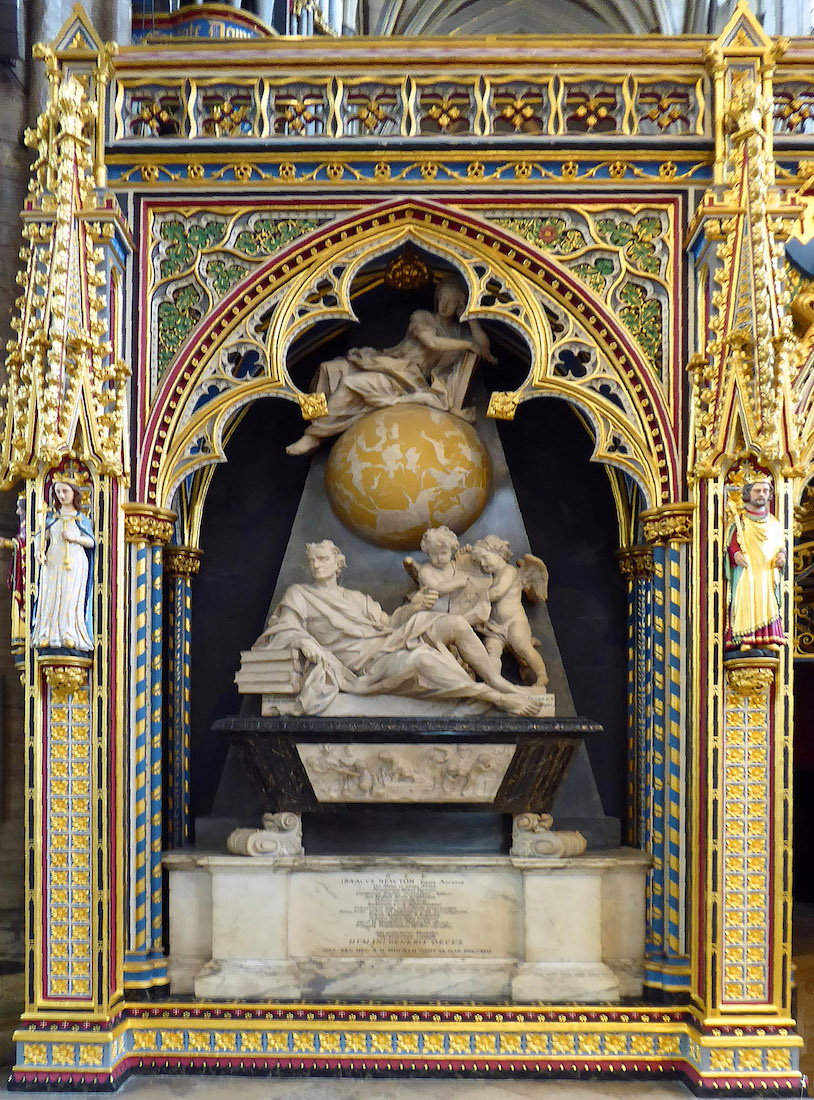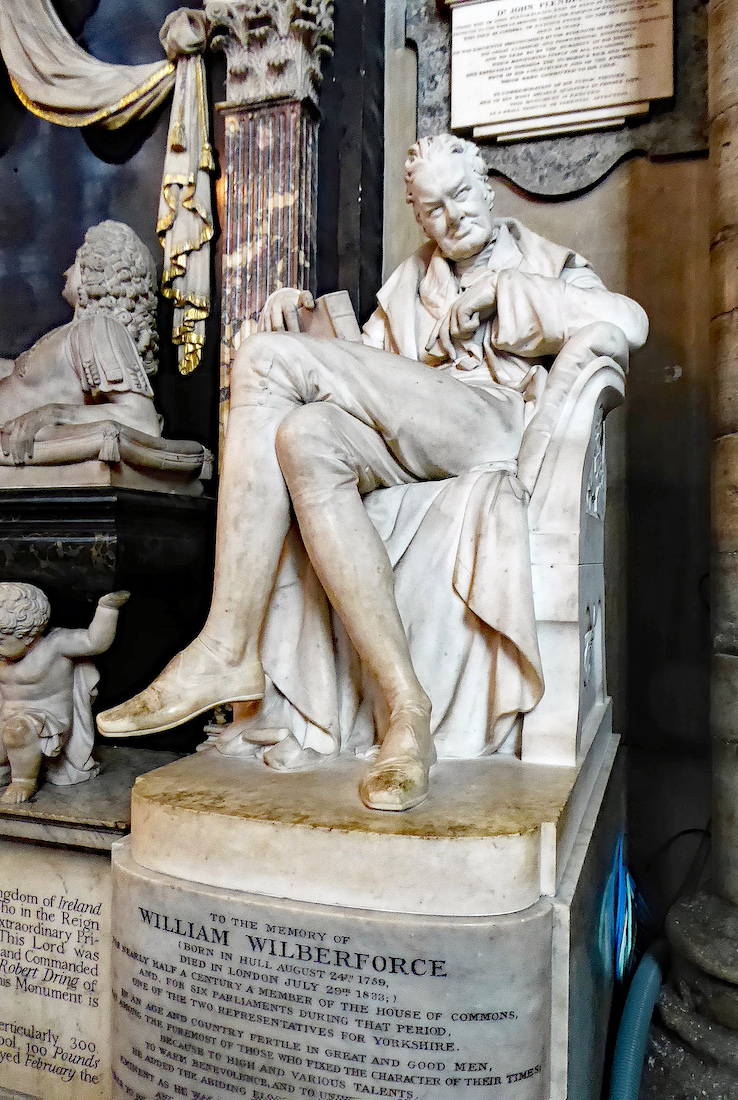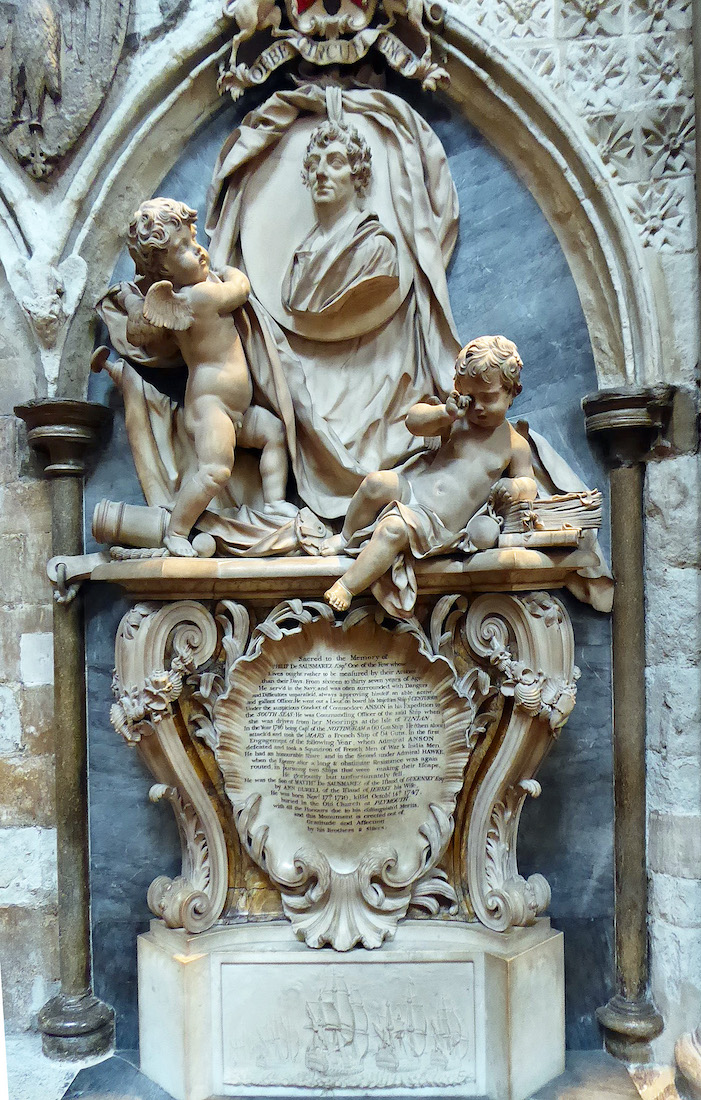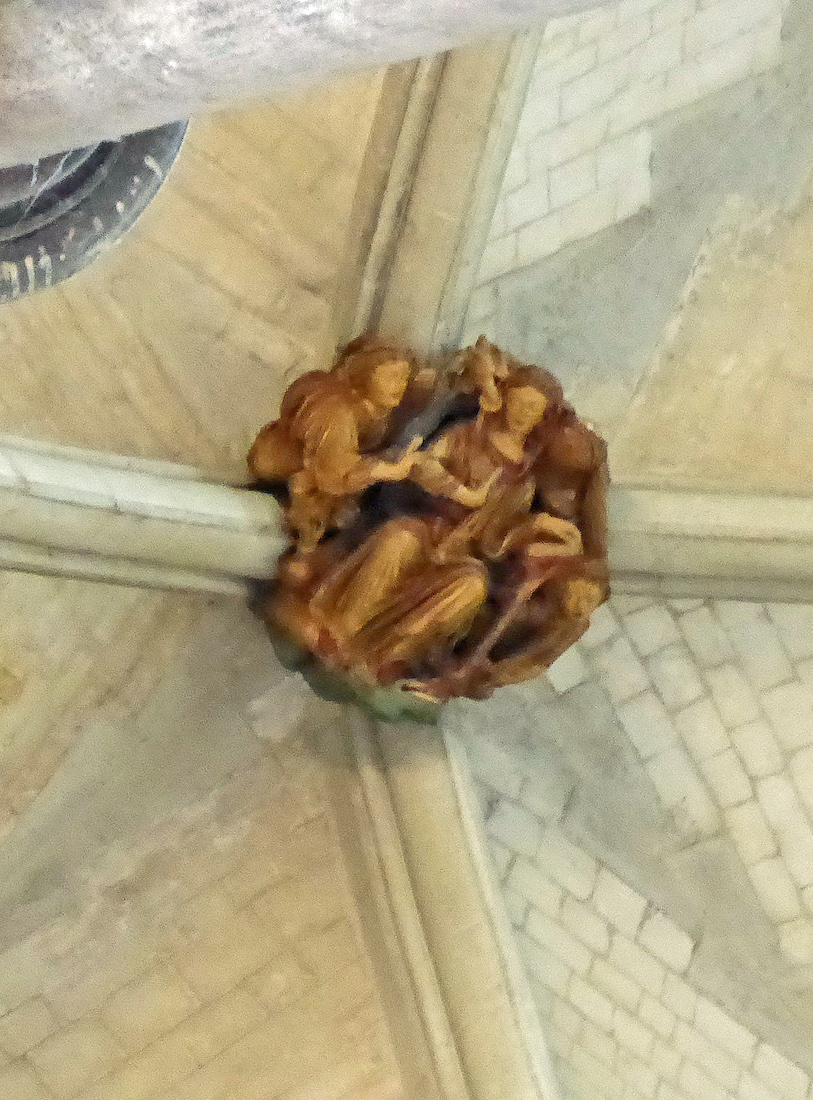C. QUIRE


Behind the nave altar is the elaborate quire screen. ‘Quire’ or ‘choir’? In ecclesiastical terminology there seems to be no distinction between the two – except that perhaps ‘quire’ is more antiquated, – and certainly no consistency. My preference is to use the word ‘quire’ to denote that section of a church or cathedral which contains the seating of the gathered ‘choir’ of singers. •• At right we see the beautiful closed grill gate: sometimes it pays to visit ‘out of hours’! INDEX
C02. SCREEN II AMT

Quire screens like this derive from the old rood screen : a physical and symbolic barrier, separating the chancel, the domain of the clergy, from the nave where lay people gathered to worship. Over the centuries, the first simple functional wooden screens became more and more elaborate and ornate. This screen has a monument on either side, and a gables central arch with gate. In fact, in this case, a much plainer screen was erected by Nicholas Hawksmoor and adorned with the two monuments (an unusual arrangement that speaks of the abbey's shortage of space!). The much richer Neo-Gothic front was added in the 1830s by Edward Blore with the colouring and gilded added in the 1950s by Stephen Dykes Bower.
C03. SCREEN MONUMENTS AMT AMT
The monument at left is to the great scientist of the Enlightenment Sir Isaac Newton (d.1727) who lies buried nearby. It was erected in 1731 to the designs of William Kent and sculpted by Michael Rysbrack and depicts Newton reclining beneath a celestial globe. •• The monument at right is to James, 1st Earl Stanhope (d.1721), and was erected in 1733. It too was designed by William Kent and sculpted by Michael Rysbrack, with a composition to balance the monument at left.
C04. CENTRE SCREEN AMT
The central archway leads us through to the quire stalls. It is very elaborate in its design. A surprising historical item is that there was serious consideration given in 1881 to have the whole screen removed from the Abbey.
C05. ORGAN AMT WA
It is quite easy for a casual visitor to miss the Abbey’s pipe organ. The console is placed on top of the (deep) quire screen, and the pipes rise up on either side. The Harrison & Harrison organ was installed for the Coronation of King George VI in 1937. With four manuals and eighty-four speaking stops, it incorporated some of the pipework from the previous five-manual instrument, built by William Hill in 1848. The organ was expanded by Harrison & Harrison in 1982 and again in 1987, resulting in the ninety-four-stop five-manual instrument we know today.
C06. QUIRE WA
As we come through the archway to the quire area, the sanctuary is seen ahead, flanked on either side by the quire stalls. The canopy arches can be seen in gold. Clergymen and members of a choir are seen occupying these stalls during services.
C07. QUIRE LOOKING WEST WA
Looking at the quire from the East, we see more clearly the two stands of organ pipes. The Abbey is very grand!
C08. QUIRE STALLS WA
The quire is where twenty-two boys and twelve lay vicars (as the men of the choir are known) sing daily services. Orlando Gibbons and Henry Purcell were organists at the Abbey. There is another set of more elaborate quire stalls in the Lady Chapel, but we are reminded that there is some interesting wood carving here too.
C09. QUIRE STALLS DETAIL AMT
There are some unexpected finds in the Abbey quire stalls, such as the coats of arms of New Zealand. Australia and Canada.
C10. QUIRE VAULTING AMT
The rib vaulting of the nave continues above the quire.
C11. NORTH QUIRE AISLE, WEST END GSV
There is an aisle on either side of the quire, shielded from view by the high backs of the quire stalls. We now enter the North aisle from the West end, passing through a smart pair of blue and gold gates.
C12. NORTH QUIRE BAY 8, MONUMENT AND WINDOW AMT AMT
There are three more bays along this aisle – Bays 8, 9 and 10. Here in Bay 8 there is another window by Sir Ninian Comper, 1913, part of the sequence in the North nave aisle depicting various medieval monarchs paired with their contemporary Abbots of Westminster. •• The monument in this bay is to Charles Agar, Earl of Normanton and later Archbishop of Dublin (d.1809). The monument is the work of John Bacon Junior.
C13. THYNNE MONUMENT AMT
Still in Bay 8, but to our right on the inner side is this monument with the recumbent effigy of Lord John Thynne by Henry Hugh Armstead. It was designed by J.L.Pearson. Rev. Lord John Thynne (1798 – 1881) was an English aristocrat and Anglican cleric, who served for 45 years as Deputy Dean of Westminster.
C14. BAY 9, WINDOW, WILBERFORCE MONUMENT AMT AMT
We come next to Bay 9. The window is by Clayton and Bell and is dedicated to James Turle who was Master of the Choristers at the Abbey from 1831–1882. It shows various Biblical and other figures, most with musical connections. •• Opposite is a memorial to the great anti-slavery politician William Wilberforce (d.1833) by Samuel Joseph. Wilberforce is best remembered for championing the abolition of slavery, a task which took 20 years to win approval but finally succeeded in 1807.
C15. BAY 10, MONUMENTS AMT (x3)
There are three monuments in North Bay 10. At left musician and composer William Croft is remembered. The Latin inscription on his grave can be translated: ‘Here lies all that was mortal of William Croft, Doctor of Music, Organist of the Chapel Royal and this Collegiate Church who died 14 of August 1727 aged 50.’ •• At centre is a memorial to John Blow. The inscription reads: ‘Here lies the body of JOHN BLOW, Doctor in MUSICK: who was Organist, Composer and Master of the Children of the Chapel Royal, for the space of 35 years; ... and also Organist of this Collegiate Church about 15 years. He was Scholar to the excellent musician Dr Christopher Gibbons and Master to the famous Mr H. Purcell, and most of the eminent masters in musick since. He died Octob. ye 1st 1708, in ye 60th year of his age. His own musical compositions, (especially his church musick) are a far noble monument to his memory, than any other can be rais'd for him.’ •• At right, and seemingly out of place is a marble monument to Captain Philip de Sausmarez. The monument, by sculptor Sir Henry Cheere, shows an oval medallion portrait, unveiled by a winged cherub. Naval trophies and shells are used as decoration and on the base is a relief of a naval battle.
C16. BAY 10, WINDOW AND MONUMENTS AMT (x3)
The window in Bay10 is in memory of renowned railway engineer Robert Stephenson (d.1859). The window was created by the studio of William Wailes (fittingly also of Newcastle) but was altered in 1934 by the replacement of the ornamental elements with clear glass, retaining only the pictorial medallions. •• The monument is to Dr Hugh Chamberlen (d.1728), and is by Peter Scheemakers and Laurent Delvaux. •• Also on the floor in this bay is a brass to Bishop James Henry Monk (d.1856), designed by G.G.Scott and executed by Hardman’s.
C17. EAST END OF NORTH QUIRE AISLE AMT AMT
Our first view shows a pair of gates at the East end of the North quire aisle, marking the East end of Bay 10. At this point the North transept opens up on our right. But strangely, there is one more inner monument on the left side, on the near side of the fence. We can understand this from the little plan, where the monument is marked in red. The monument, shown at right, is to politician Sir Thomas Hesketh (d.1605).
C18. NORTH QUIRE AISLE BOSSES AMT AMT
The roof bosses here are interesting. With Gothic vaulting, roof bosses of various design are used to cover the places where ribs of the vaulting join.
C19. WEST END OF SOUTH QUIRE AISLE GSV AMT
We next retrace our steps and walk up the South quire aisle, beginning at the West end. Another pair of blue gates, and reminder that certain sections of the Abbey may be closed from time to time, for example for maintenance. This aisle follows the pattern of the North aisle with Bays 8, 9, 10 and in fact also 11, as expected from the above plan.
C20. SOUTH QUIRE AISLE BAY 8, MONUMENTS GSV
Walking through the gate we come to South Bay 8, and we find this collection of monuments on the wall to our right. Because the wall backs on to the cloisters, we do not expect to find any windows along here.































